Author: Greg Merchant, Dan Schlaff, Derek Pankratz
Date: 17 August 2017
Publisher: Deloitte
Link: https://www2.deloitte.com/us/en/insights/focus/future-of-mobility/opportunities-for-media-and-entertainment-industry.html
For most of automotive history, drivers have been limited when it comes to in-car entertainment. Although there are expanding options for those with the funds, and streaming music may have mostly supplanted FM radio and cassette tapes, the entertainment experience for most drivers today is largely unchanged from when the Galvin brothers installed the first AM dashboard radio in a Studebaker in 1930.1
But what happens when a “driver” no longer needs to keep her eyes on the road and her hands upon the wheel? Autonomous vehicles are about to transform the possibilities for what the in-transit media experience can be across all forms of personal transportation.
An entirely new ecosystem of personal mobility seems to be emerging, fueled by the advancement of autonomous and connected vehicles, ridesharing, and other developments. As shared and autonomous mobility proliferate, an opportunity arises for companies seeking to sell content, entertain, and enhance the time spent in transit.
As shared and autonomous mobility emerge and coexist, media companies have an opportunity to play an active role in shaping the ecosystem. If they don’t seize the opportunity to develop compelling and differentiated products, they could forgo that chance. They should be asking questions such as:
- What will the in-transit entertainment experience be in the future? What should our role be?
- What is the size of the opportunity? When should we act—and can’t we just take a wait-and-see approach?
- What media products and services could emerge across the mobility ecosystem? Doesn’t the smartphone already provide all the mobile entertainment consumers want?
- What players will emerge to provide tomorrow’s mobility experience? With whom should we consider partnering?
- How can media companies provide a seamless content experience when consumers could use a different mode of transit and vehicle for every ride segment?
The Emerging Mobility Ecosystem
Vehicle designers and manufacturers
The in-vehicle experience starts, naturally, with the vehicle itself. Established automakers, along with new entrants, could manufacture vehicles that are increasingly diverse—from larger personally owned self-driving vehicles that can pick up kids from school and groceries from the store to utilitarian shared autonomous pods that let passengers focus on work as they flit across town to their next meeting.
Importantly, automakers could increasingly design vehicles to be flexibly tailored to the specific purpose of any given journey, with interiors optimized for entertainment, productivity, relaxation, and more.
Mobility managers
As shared, connected autonomous mobility proliferates, many expect to see the emergence of mobility as a service (MaaS): digital platforms that integrate end-to-end trip planning, booking, electronic ticketing, and payment services across all modes of transportation.7 Consumers today are able to curate their audio and video content experience through a common software platform across their home and mobile devices; MaaS could extend the media experience to the vehicle, seamlessly integrating content libraries, streaming subscriptions, and social networking into each and every ride. By managing this information along with individual mobility data, MaaS providers would be able to recommend content types and lengths suited to each journey, personalizing the in-transit mobility experience to each passenger’s individual tastes.
Infrastructure enablers
A world of connected mobility that includes integrated and immersive media experiences in every vehicle is inconceivable without a ubiquitous network of fast and reliable connectivity.8 Connecting every vehicle to one another and the surrounding environment in order to deliver information, entertainment, and communication access to riders would be a key role for telecommunications companies. Securing those connections would also be critical.
Experience enablers
Finally, and most critically for media companies, the in-vehicle experience will be defined by the types of content available to passengers. This could, of course, include music, radio programming, podcasts, and audio-based advertising similar to what we listen to in our cars today. But if autonomous vehicles become an everyday reality, drivers would be freed from the need to operate the pedals and steering wheel every minute on the road, and vehicle design could likely focus more on the interior experience for riders9—opening up the possibilities for all kinds of media to enter the vehicle.
Television and film studios, videogame developers, social media platforms, business and education publishers—all of these players and more could produce and curate the content that passengers enjoy, utilize, and generally interact with while in transit.
Tomorrow’s Vehicle Experience: Erica
As new types of mobility take hold, the media experiences enjoyed in transit could be at least as diverse as today’s home entertainment options. To illustrate the possibilities, let’s take a peek at Erica’s day.
It’s Saturday morning, and Erica and her family have a day trip planned to visit her parents, who live an hour and a half away. While they could summon a shared autonomous pod to take them for the day, the family decides to use their larger self-driving vehicle—the one the family owns partly for its ability to earn extra income as part of a ridesharing fleet during the weekdays while Erica and her husband are working and the kids are in school.
Their personally owned vehicle is ideal for family trips. The interior is configured to allow each passenger to enjoy his or her own video and audio experience without hearing or seeing each other’s—or alternatively share in the same experience, if anyone wants to. Through its connection to the family’s streaming service account and preference configurations, the vehicle knows to start playing Erica’s two children’s favorite movies the instant they sit down in the back seat. In his own seat, her husband selects the productivity setting on the vehicle touchscreen, and the seating area automatically configures to enable him to catch up on some emails for work; naturally, all of his work accounts and files are instantly accessible. Erica, tired from the busy workweek, simply selects a jazz playlist to listen to in her seat. Neither is disturbed by the sounds of the cartoons in the back seat, thanks to the vehicle’s individually targeted audio speaker system.10
On the ride home that evening, the kids are hungry, and Erica looks for dinner options. Through the voice-activated controls, she requests healthy restaurant recommendations no more than 15 minutes off of their route home. A menu of options with ratings, hours, and routing info fills the augmented reality (AR) windshield. Because their vehicle system recalls their dining history and preferences, it highlights several options that offer time-sensitive specials and discounts to help the family choose a restaurant agreeable to all. After a quick bite to eat, the foursome decides some friendly competition is in order, and they pass the remainder of the ride in a heated game of virtual car racing.
Impact Across the Media Landscape:

What Should Media Companies Begin Doing?
While some industries will likely struggle to find their way in the new mobility ecosystem, few seem to have as much unmitigated potential upside as the media sector. Unlike with automakers or insurance providers, shifts in mobility are unlikely to challenge existing revenue sources or necessitate radical business model transformations.
Still, media companies likely cannot afford to be complacent. As the rise of digital content and streaming services seem to illustrate, there is no shortage of new entrants prepared to capitalize on emerging technologies—especially as barriers to market entry continue to fall. Media companies will need to choose their preferred strategy to properly prepare, and the consequences of different routes are clear: Employing a wait-and-see approach will likely relegate a media company to being a price-taker at the mercy of the larger ecosystem players. Working to develop the experience of the future has risk as well, and media companies should be confident they can compete. And they should be brutally honest with themselves: about their capabilities, strengths, and weaknesses. Regardless of path, media players that drag their feet could start well behind.
To that end, media companies should begin positioning themselves for the future of mobility now by:
Determining partnership opportunities and potential models. Media players should think expansively and consider nontraditional partners—including automakers, suppliers, access providers, and mobility managers—to develop the future in-vehicle experience. Media companies likely cannot build this future themselves but can nonetheless fulfill a critical element of the mobility experience. Establishing sustainable and valuable partnerships with other mobility players may be essential to their survival and success. Determining ownership of and access to data, a key driver of value, is likely to be an important component of any agreement’s terms.
Focusing on product innovation. Just as video game consoles and smartphones introduced platforms with new possibilities, autonomous vehicles could be a blank canvas for media companies to explore innovative types of content. Across subsectors, media firms should review both their existing and planned product and service portfolios against the different types of mobility. Executives will need to determine if they believe these products and services could create additional value in the future mobility ecosystem and, where there are gaps, develop an innovation agenda around ideas that can enable them to capture opportunity. That likely requires the ability to deliver current products in enhanced ways, as well as delivering entirely new types of products. Approaching the challenge through the consumer’s eyes and the types of experiences people are likely to want could be key to enabling fresh thinking.
Exploring monetization models based around potential future states. As new types of mobility emerge, media consumption patterns will likely evolve along with them. Media companies therefore should explore how these patterns can impact their current advertising and/or subscription-based revenue models, and how shared and autonomous mobility can either threaten or enhance those models. For example, as MaaS evolves, mobility advisers will likely aim to streamline the payments process for riders not only to include the cost of the ride itself but to incorporate in-transit purchases for services, including entertainment, into one simple payment through a rider’s mobile device. This means that media companies may consider partnership agreements with MaaS providers—and to evaluate how a mobility-based subscription model can fit into such an integrated payment platform.
This article goes into lengthy detail about the business opportunities that media companies can opt into as cars begin their transition towards autonomy. After looking at how various tech can be integrated into vehicle experience, it was interesting to see the disruptive means of media integration discussed in this article, particularly that of film and video and gaming. The business model for this is really important to take note of as well, considering that transportation is expected to migrate towards being a service rather than something a person owns. That being said, seeing the various ways of media integration not only gives us as designers plenty of inspiration, but it will help us set up for an appropriate transition to higher levels of autonomy. This article seems to focus on media possibilities that could exist at higher autonomy levels, but perhaps there is a way we can integrate some of these concepts into a vehicle with a more rigid set of constraints.
Merchant, G., Schlaff, D., & Pankratz, D. (2017, August 17). Experiencing the future of mobility. Deloitte Insights. Retrieved September 26, 2021, from https://www2.deloitte.com/us/en/insights/focus/future-of-mobility/opportunities-for-media-and-entertainment-industry.html.




